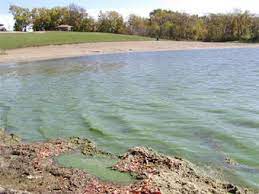Wheat farmers adore the hot dry weather during wheat harvest, as it dries the crop and allows for harvesting without worrying about wet spots in fields. But, along with extended periods of hot dry weather often come blue-green algae blooms at lake and reservoirs. I know all you K State fans love your “Royal Purple”, and KU fans adore your red and blue, and those colors are just the ticket to adorn T shirts, umbrellas and ball caps in support of your chosen team. But when the waters of your favorite lake take on those same colors, lookout!
Welcome to algae bloom season again in Kansas. This period of summer runs from May through October, the months sporting the longest days of sunlight and the warmest water temperatures, and unfortunately this time frame also encompasses the three holidays when our lakes are used the most, Memorial Day, Fourth of July and Labor Day. Blue-Green Algae are bacteria with a scientific name as long as a yardstick, that exist naturally in rivers, lakes and ponds and all aquatic ecosystems here in Kansas. When certain conditions align, such as exceptionally high nutrient content in the water, and long hot days with lots of sunlight, those bacteria can reproduce more rapidly than usual, causing a dense growth of algae known as “a bloom.” Some algae blooms are harmless, but when the blooming organisms contain toxins, noxious chemicals or pathogens in levels harmful to humans and animals, it is declared to be a “Harmful Algae Bloom,” and warnings or advisories are issued by the Kansas Department of Health and Environment, (KDHE.) These blue-green algae blooms can be blue, bright green, brown or even red, and may look like foam or a thick frothy slurry. Some blooms, however may not even affect the appearance of the water.
When KDHE receives notice from anyone that a harmful algae bloom is noticed or suspected, they take water samples at the most frequently used locations at the site, such as swim beaches and boat docks. The samples are analyzed, and according to the density of the algae found, either a Public Health Watch or a Public Health Warning is issued for that water impoundment.
A Public Health Watch
• Notifies the public that a hazardous condition MAY exist
• Signs MAY be posted at all public access locations
• Water MAY be unsafe for humans/animals
• Contact with the water is discouraged
There are no current public health watches for any Kansas lakes.
A Public Health Warning
• Notifies the public that condition ARE unsafe
• Signs WILL be posted at public access locations
• Contact with the water SHOULD NOT OCCUR
Public Health Watches are currently in effect at the following lakes; Big Hill Lake in Labette County, Milford Lake Zone “C” in Geary County and South Lake in Johnson County. Public Health Warnings are currently in effect at Big Eleven Lake in Wyandotte County, Jerry Ivey Pond in Saline County, Keith Sebelius Reservoir in Norton County, both Marion County Lake and Marion County Reservoir in Marion County, Melvern Outlet Pond in Osage County and Webster Reservoir in Rooks County. Keep abreast of current algae watches and warnings on www.ksoutdoors.com.
Health effects can occur when surface scum or water containing high levels of blue-green algal toxins are swallowed or have contact with exposed skin, or when airborne droplets containing toxins are inhaled while swimming, boating or skiing. Most people report the effects as “allergic” type reactions like intestinal or respiratory problems or skin irritations. Animal reactions may range from general weakness and lethargy, to vomiting, diarrhea, difficulty breathing or even convulsion. Algae blooms don’t usually envelope an entire lake, so places can still be found to fish on lakes under blue-green algae watches and warnings, and according to the folks in-the-know at the Kansas Dept of Wildlife, Parks and Tourism, fish caught from affected lakes can still be safely eaten, just wash the meat thoroughly.
My friend used to say “Everybody always tells me – Cheer up, things could be worse. So, I cheered up, and sure enough – things got worse!” Sorry to say that health warnings at area lakes because of toxic algae blooms will probably get more numerous before they get better. I guess your options are to sell the boat, skis and fishing poles, or just drive a little farther to a lake where no warnings exist, and continue to Explore Kansas Outdoors!
Steve can be contacted by email at stevenrgilliland@gmail.com.




